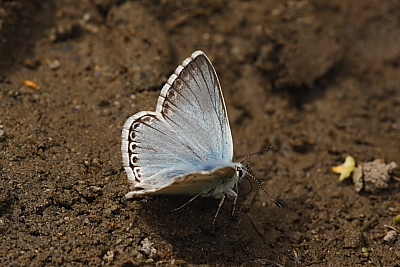
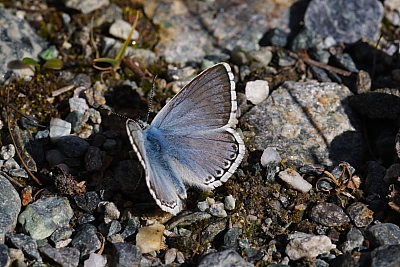
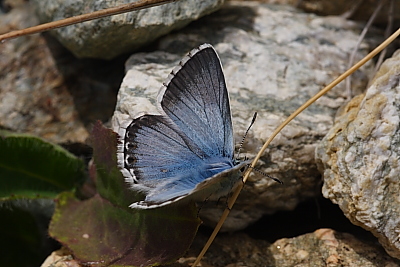
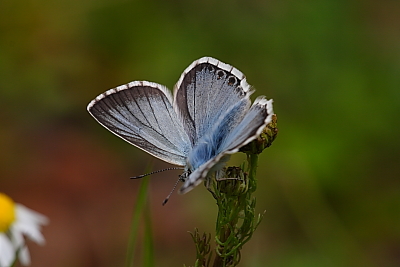
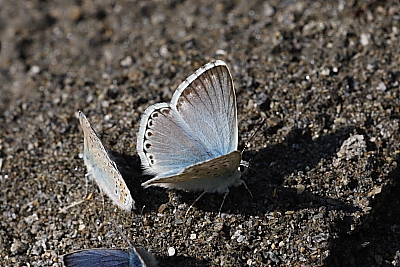
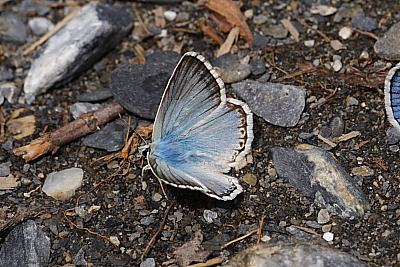
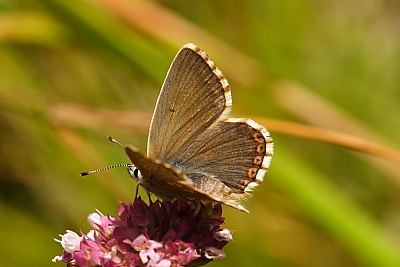
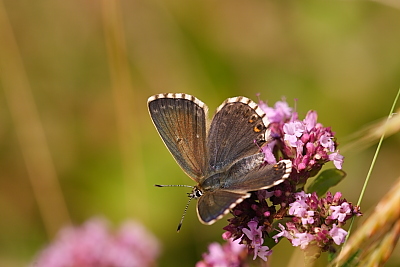
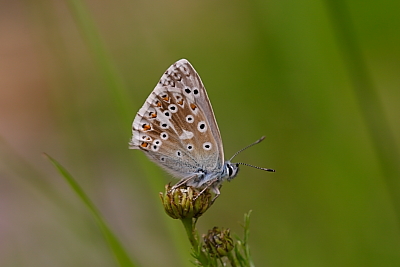
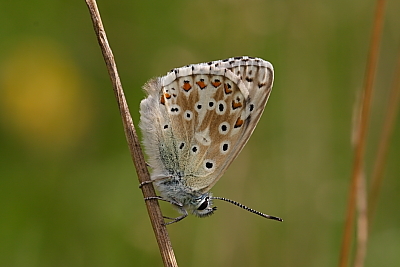
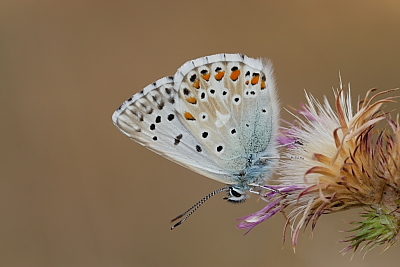
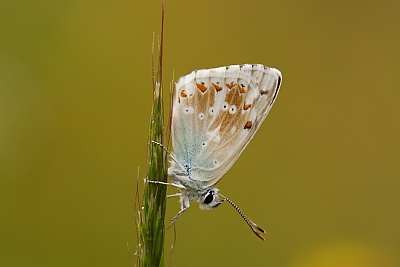
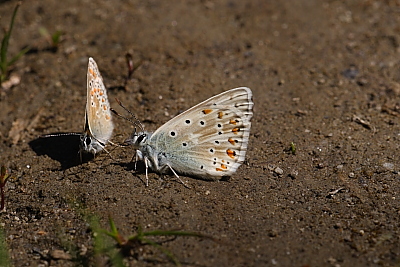
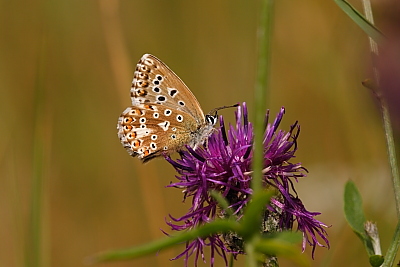
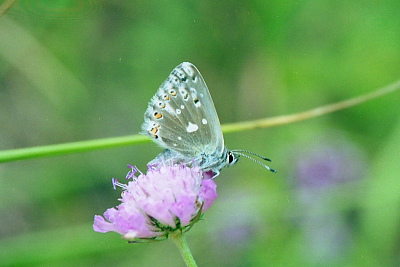
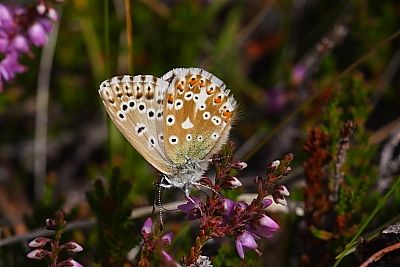
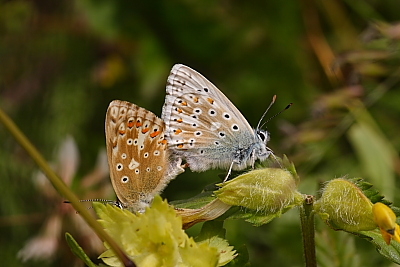
Chalk-hill Blue (Polyommatus coridon)
2024 photographs highlighted in yellow. Click on any photograph to go to an enlarged picture, or simply scroll down the page.
|
Coridon and the Provence Chalk-hill Blue (P. hispanus) can be difficult to tell apart, especially so from the female upperside. The male upperside of hispanus is a rather duller silvery blue, often being rather yellowish at the margins. Coridon can be quite variable, just to make things more difficult, but it is single-brooded and a relatively late emerger, even in the far south of France, so any specimens seen in May or early June will almost certainly be hispanus, and this has been borne out by other indicators.
There is a second generation of hispanus later in the summer, when they and coridon can fly at the same time and locations, although hispanus is on the wing into October. I have also found that the inner edge of the hispanus unf lunules are often larger and smudgily indistinct. |
Lafranchis says that the coridon unh is tinged brown and contrasts with the paler grey unf, while the hispanus unh is also pale grey and there is minimal colour contrast; this seems to be true but there are grey (sic) areas. The female coridon I have seen in the Pyrénées, especially at altitude, were quite often greyish rather than the usual brown, and the extent of the ups marginal lunules varied quite significantly.
This species was previously known as Lysandra coridon. In 2010 it was reclassified as Polyommatus coridon and in 2017 it was again reclassified back to Lysandra coridon. I'll give it a few years before changing the web page (and all the occurrences and links associated) as it is entirely possible that the taxonomists will change it again.
In most text books the English name is given as Chalk-hill, but in the 2017 taxonomy it is given as Chalkhill, and the Butterfly Conservation web site refers to it as Chalk Hill. |
| ref | sex |
observations |
alt. m |
| 17970 | M |
I am not really 100% sure that this is coridon. The lack of blue tends to suggest that it may be hispanus but the date and location/altitude point to coridon. The upf marginal markings are quite pronounced. |
1120 |
| 22951 | M |
a rather darker male, with well defined upf borders. |
1800 |
| 31253 | M | a male, rather bluer than the norm, with quite wide black borders. | 2180 |
| 36450 | M | a male, typical for a this species at altitude. 36445 is the underside. | 1640 |
| 38202 | M | a male, from the Hautes-Alpes. | 2020 |
| 39197 | M | a male, from the Hautes-Pyrénées, showing little difference from those from the Alpes. | 1600 |
| 8932 | F |
a typical female, quite dark brown and with relatively small uph marginal lunules. |
1600 |
| 23388 | F |
a UK female, quite dark and having a distinct greyish feel, especially on the uph. |
90 |
| 36445 | M | a male, the underside of 36450. | 1640 |
| 36591 | M | a male, from lower altitude in central France. | 320 |
| 8599 | M |
this male has quite a pale underside, especially the unh, but with strong orange lunules. |
780 |
| 8907 | M |
a very pale male underside especially in the basal area and unusually transitioning to a quite deep brown in the marginal areas. The markings are very light and the orange lunules uncharacteristically very thin, although quite distinct. |
1500 |
| 22663 | M |
a rather lightly marked male underside, not uncommon I find in high altitude specimens. |
1120 |
| 23424 | F |
a female, from the same UK location as 23388, also rather dark. |
90 |
| 05_24-21 | F |
a dark grey female of the form corydonis. I have seen dark grey females in the Pyrénées before, but none that was as markedly so as this. The upperside was also noticeably greyer. |
|
| 27740 | F | a typical female. | 2160 |
| 27002 | PAIR | a mating pair, the paler, greyer, male on the right. | 2010 |
22951_male_Valais, Switzerland_24Jul10
31253_male_Valais, Switzerland_15Jul12
36450_male_Valais, Switzerland_20Jul14
38202_male_Hautes-Alpes_7Jul15
39197_male_Hautes-Pyrénées_24Jul15
8932_female_Hautes-Pyrénées_8Aug07
23388_female_Buckinghamshire, UK_8Aug10
36445_male_Valais, Switzerland_20Jul14
8907_male_Hautes-Pyrénées_5Aug07
23424_female_Buckinghamshire, UK_8Aug10
05_24-21_female_Hautes-Pyrénées_Jul05 - form corydonis
27740_female_Valais, Switzerland_22Jul11
27002_pair_Hautes-Alpes_12Jul11